Vishnu is generally considered to have had ten incarnations or avatars, of which nine are past and one is still to come. The incarnations were as follows:
| 1 | 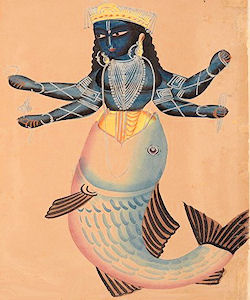 As matsya, a great fish, he guided the ark in which Manu the primeval man escaped from the deluge. The first incarnation, called the Matsya, or Fish Avatar, was for the purpose of recovering the Vedas, the sacred books of India, which had been stolen by demons and buried in the waters of a deluge that then covered the world. It is interesting to note in passing that in every system of mythology, from the Hindoo to the American Indian, there is reference to a great deluge; and Noah has his correspondences in every one of them. The Hindoos believe that in the reign of the seventh Menu Satyavrata, the whole world and mankind having become corrupt, were destroyed by a flood, and that only Manu, with the seven Rishis and their wives, were saved. The salvation was effected by Vishnu, who commanded them to enter a spacious vessel accompanied by pairs of all the animals. Then Vishnu, taking the form of a great horned fish, commanded that the ark should be fastened by a cable, composed of a serpent, to his mighty horn, that it might thus be secure until the flood subsided. As matsya, a great fish, he guided the ark in which Manu the primeval man escaped from the deluge. The first incarnation, called the Matsya, or Fish Avatar, was for the purpose of recovering the Vedas, the sacred books of India, which had been stolen by demons and buried in the waters of a deluge that then covered the world. It is interesting to note in passing that in every system of mythology, from the Hindoo to the American Indian, there is reference to a great deluge; and Noah has his correspondences in every one of them. The Hindoos believe that in the reign of the seventh Menu Satyavrata, the whole world and mankind having become corrupt, were destroyed by a flood, and that only Manu, with the seven Rishis and their wives, were saved. The salvation was effected by Vishnu, who commanded them to enter a spacious vessel accompanied by pairs of all the animals. Then Vishnu, taking the form of a great horned fish, commanded that the ark should be fastened by a cable, composed of a serpent, to his mighty horn, that it might thus be secure until the flood subsided.
|
| 2 | 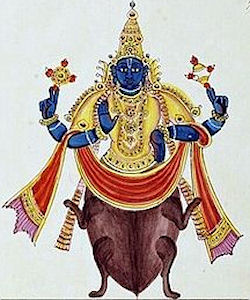 The second grand avatar of Vishnu is called the Korma or Tortoise Avatar, and a detailed study of this legend will well repay any one interested in religious symbolism. Only a short account of it, however, can be given here, and the existence of its hidden symbolism but briefly pointed out. For the purpose of restoring to man some of the treasures that were lost in the flood, Vishnu is said to have reincarnated in the form of a giant tortoise. Then, placing upon his back the mountain Mandara, the world-pillar, and winding about the pillar the serpent Vasoky, symbol of eternity, Vishnu called to the gods and demons, with whose assistance he churned the sea (of milk) for the recovery of the Amrita, or beverage of immortality. The second grand avatar of Vishnu is called the Korma or Tortoise Avatar, and a detailed study of this legend will well repay any one interested in religious symbolism. Only a short account of it, however, can be given here, and the existence of its hidden symbolism but briefly pointed out. For the purpose of restoring to man some of the treasures that were lost in the flood, Vishnu is said to have reincarnated in the form of a giant tortoise. Then, placing upon his back the mountain Mandara, the world-pillar, and winding about the pillar the serpent Vasoky, symbol of eternity, Vishnu called to the gods and demons, with whose assistance he churned the sea (of milk) for the recovery of the Amrita, or beverage of immortality.
|
| 3 | 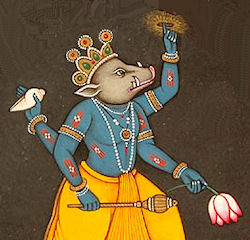 As Varaha, a boar, he dived under the sea and raised the earth on his tusks after it had been submerged by a demon as a punishment for the iniquities of its inhabitants. This avatar, like the two preceding, seems to have reference to the general deluge. A certain daitya (demon), having performed various acts of devotion and having spent a lifetime in religious austerities, had thereby earned the right to demand of Brahma any boon that he might wish. He demanded universal empire and freedom from danger through noxious animals, which he carefully enumerated one by one; but, notwithstanding his precautions, he forgot to name the boar. Brahma, being unable to refuse a boon to one who had earned the right to ask it by religious austerities, granted the prayer of the demon and gave him dominion over the earth and over all the animals he had enumerated. Thereupon the daitya seized the earth that had become his own, and plunged with it to the bottom of the sea. Vishnu, in order to save the earth from the clutches of this demon, took on the form of the boar, which was the one noxious animal his enemy had forgotten to enumerate. As Varaha, a boar, he dived under the sea and raised the earth on his tusks after it had been submerged by a demon as a punishment for the iniquities of its inhabitants. This avatar, like the two preceding, seems to have reference to the general deluge. A certain daitya (demon), having performed various acts of devotion and having spent a lifetime in religious austerities, had thereby earned the right to demand of Brahma any boon that he might wish. He demanded universal empire and freedom from danger through noxious animals, which he carefully enumerated one by one; but, notwithstanding his precautions, he forgot to name the boar. Brahma, being unable to refuse a boon to one who had earned the right to ask it by religious austerities, granted the prayer of the demon and gave him dominion over the earth and over all the animals he had enumerated. Thereupon the daitya seized the earth that had become his own, and plunged with it to the bottom of the sea. Vishnu, in order to save the earth from the clutches of this demon, took on the form of the boar, which was the one noxious animal his enemy had forgotten to enumerate.
|
| 4 | 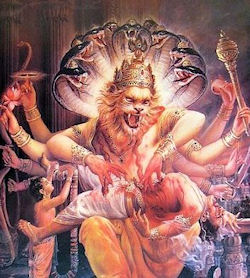 As Narsingh, the man-lion, he delivered the world from the tyranny of the demon Hiranyakasipu. The Hiranyakasipu spent ten thousand years in acts of religious austerity, then claimed at the hands of Brahma the usual boon, universal dominion; and the request for exemption from danger he carefully framed to be exempt from death at the hands of god or man; that no noxious animal should hurt him; and this was to protect him by day or night, within doors or without, in heaven or on earth. Secure in these endowments, he became so arrogant that his conduct was no longer to be borne; so Vishnu, to gratify Lakshmi's desire for a battle and also to rescue mankind, descended to the earth in the form of Nara-Singha, the man-lion. These first four avatars were in the earliest age, the Satya Yuga of the Hindoos, which corresponds to the "golden age " of other mythologies. As Narsingh, the man-lion, he delivered the world from the tyranny of the demon Hiranyakasipu. The Hiranyakasipu spent ten thousand years in acts of religious austerity, then claimed at the hands of Brahma the usual boon, universal dominion; and the request for exemption from danger he carefully framed to be exempt from death at the hands of god or man; that no noxious animal should hurt him; and this was to protect him by day or night, within doors or without, in heaven or on earth. Secure in these endowments, he became so arrogant that his conduct was no longer to be borne; so Vishnu, to gratify Lakshmi's desire for a battle and also to rescue mankind, descended to the earth in the form of Nara-Singha, the man-lion. These first four avatars were in the earliest age, the Satya Yuga of the Hindoos, which corresponds to the "golden age " of other mythologies.
|
| 5 | 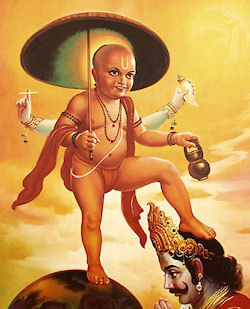 The fifth avatar of Vishnu is known as the Vamana, or Dwarf Avatar, and occured in the second age, the Tyrta Yuga. As Vaman or wamana, a dwarf, he tricked the King Bali, who had gained possession over the earth and nether world and was threatening the heavens, by asking for as much ground as he could cover in three steps. As the water from the king's pitcher fell upon the hand of the dwarf, his meager form expanded till it filled the world; and Vishnu, now appearing in his own person, deprived Beli of two steps of heaven and earth; but as the raja was on the whole a virtuous monarch, Vishnu left hell still in his dominion. In this character of the dwarf, Vishnu is sometimes called Trivikrama, the thrce-step-taker; and there is a fable that the stream poured over his hand by Beli became the river Ganges. The fifth avatar of Vishnu is known as the Vamana, or Dwarf Avatar, and occured in the second age, the Tyrta Yuga. As Vaman or wamana, a dwarf, he tricked the King Bali, who had gained possession over the earth and nether world and was threatening the heavens, by asking for as much ground as he could cover in three steps. As the water from the king's pitcher fell upon the hand of the dwarf, his meager form expanded till it filled the world; and Vishnu, now appearing in his own person, deprived Beli of two steps of heaven and earth; but as the raja was on the whole a virtuous monarch, Vishnu left hell still in his dominion. In this character of the dwarf, Vishnu is sometimes called Trivikrama, the thrce-step-taker; and there is a fable that the stream poured over his hand by Beli became the river Ganges.
|
| 6 | 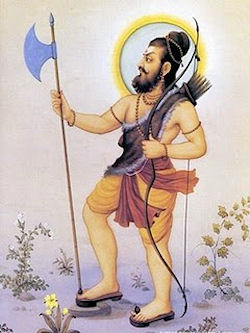 As Parasurama or Parasu Rama, he cleared the earth of the Kshatriyas, who had oppressed the Brahman hermits and stolen the sacred cow, by a slaughter of them thrice seven times repeated. There is some complexity in the Rama legends, as Vishnu is said to have incarnated in the person of three Ramas, youths of perfect beauty, named respectively Bala Rama, Parasu Rama, and Rama Chandra; though only the two latter names are given in the many lists of his avatars that the author has consulted. This complexity seems to have puzzled most students, and an examination of a dozen good authorities does not show one wrtier who has satisfactorily explained it. Parasu Rama was a mighty conqueror, and had an army of large monkeys (or satyrs) commanded by Hanuman, the monkey-god. The pictures of this avatar generally represent the combat between Parasu Rama and the Raja with the twenty arms, some of which are scattered about, severed by the weapon of his semi-divine opponent. Thus this avatar is often called the Battle-ax Incarnation, and is semi-historical in its character, illustrating the battle for supremacy between the warrior-caste and the Brahmins. As Parasurama or Parasu Rama, he cleared the earth of the Kshatriyas, who had oppressed the Brahman hermits and stolen the sacred cow, by a slaughter of them thrice seven times repeated. There is some complexity in the Rama legends, as Vishnu is said to have incarnated in the person of three Ramas, youths of perfect beauty, named respectively Bala Rama, Parasu Rama, and Rama Chandra; though only the two latter names are given in the many lists of his avatars that the author has consulted. This complexity seems to have puzzled most students, and an examination of a dozen good authorities does not show one wrtier who has satisfactorily explained it. Parasu Rama was a mighty conqueror, and had an army of large monkeys (or satyrs) commanded by Hanuman, the monkey-god. The pictures of this avatar generally represent the combat between Parasu Rama and the Raja with the twenty arms, some of which are scattered about, severed by the weapon of his semi-divine opponent. Thus this avatar is often called the Battle-ax Incarnation, and is semi-historical in its character, illustrating the battle for supremacy between the warrior-caste and the Brahmins.
|
| 7 | 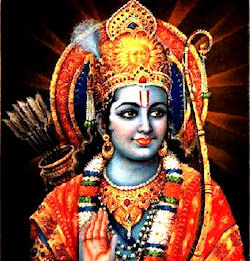 As Rama or Ramachandra, the divine king of Ajodhia or Oudh, he led an expedition to Ceylon for the recovery of his wife Sita, who had been abducted by Rawan, the demon king of Ceylon. This story probably refers to an early expedition of the Aryans to southern India, in which they may have obtained the assistance of the Munda tribes, represented by Hanuman and his army of apes. As Rama or Ramachandra, the divine king of Ajodhia or Oudh, he led an expedition to Ceylon for the recovery of his wife Sita, who had been abducted by Rawan, the demon king of Ceylon. This story probably refers to an early expedition of the Aryans to southern India, in which they may have obtained the assistance of the Munda tribes, represented by Hanuman and his army of apes.
|
| 8 | 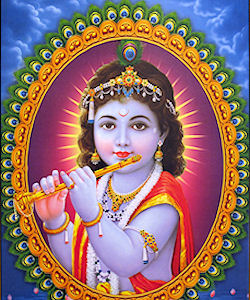 As Krishna he supported the Pandavas in their war against the Kauravas, and at the head of the Yadava clan founded the city of Dwarka in Gujarat, where he was afterwards killed. The popular group of legends about Krishna in his capacity of a cowherd in the forests of Mathura was perhaps at first distinct and afterwards combined with the story of the Yadava prince. But it is in this latter character as the divine cowherd that Krishna is most generally known and worshipped. Krishna, "the dark-skinned one," is said to have contained the plenitude of Vishnu's power and glory. In his other avatars Vishnu assumed but a portion of his divinity, while Krishna was Vishnu himself in mortal mold. So many and varied are the legends connected with the romantic history of Krishna, that volumes would be needed to recount them. Probably the most generally famous of the literary compositions inspired by this man-god is the dialogue between " The Divine One" (Krishna) and Arjuna, called the Bhagavad-Gita, from the Mahabharata. As Krishna he supported the Pandavas in their war against the Kauravas, and at the head of the Yadava clan founded the city of Dwarka in Gujarat, where he was afterwards killed. The popular group of legends about Krishna in his capacity of a cowherd in the forests of Mathura was perhaps at first distinct and afterwards combined with the story of the Yadava prince. But it is in this latter character as the divine cowherd that Krishna is most generally known and worshipped. Krishna, "the dark-skinned one," is said to have contained the plenitude of Vishnu's power and glory. In his other avatars Vishnu assumed but a portion of his divinity, while Krishna was Vishnu himself in mortal mold. So many and varied are the legends connected with the romantic history of Krishna, that volumes would be needed to recount them. Probably the most generally famous of the literary compositions inspired by this man-god is the dialogue between " The Divine One" (Krishna) and Arjuna, called the Bhagavad-Gita, from the Mahabharata.
|
| 9 | 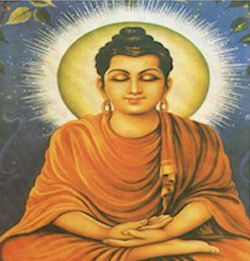 As Buddha he was the great founder of the religion known by his name; the Brahmans, by making Buddha an incarnation of Vishnu, have thus provided a connecting link between Buddhism and Hinduism. As Buddha he was the great founder of the religion known by his name; the Brahmans, by making Buddha an incarnation of Vishnu, have thus provided a connecting link between Buddhism and Hinduism. |
|
| 10 | 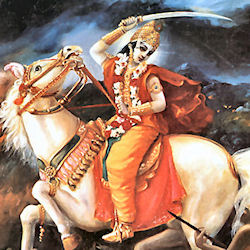 In his tenth incarnation as Kalki, he will come again as Nishka-lanki or the stainless one for the final regeneration of the world, and his advent is expected by some Hindus, who worship him in this form. At the end of the Kali or Iron Age (the present age according to Hindoo reckoning): "Thoughtless men shall begin to commit acts deserving of hell; and the destruction of castes shall be continued. Then shall virtue and religion disappear, and scarce a single school remain; and barbarians, under the forms of kings, externally arrayed in justice, but internally composed of injustice, shall devour the people. But at length shall Vishnu appear as Kalki (the winged white horse), destroy the barbarians, and reestablish the pure customs which depend on a due observance of the duties prescribed to castes and to the four classes: after which shall Hari (Vishnu) return to heaven; and the Satya Yug (golden age), then returning, shall restore the world to purity, virtue, and piety.» The pictures of this expected avatar represent the white horse with one foot raised. When he places the foot down, the time of the incarnation will be fulfilled In his tenth incarnation as Kalki, he will come again as Nishka-lanki or the stainless one for the final regeneration of the world, and his advent is expected by some Hindus, who worship him in this form. At the end of the Kali or Iron Age (the present age according to Hindoo reckoning): "Thoughtless men shall begin to commit acts deserving of hell; and the destruction of castes shall be continued. Then shall virtue and religion disappear, and scarce a single school remain; and barbarians, under the forms of kings, externally arrayed in justice, but internally composed of injustice, shall devour the people. But at length shall Vishnu appear as Kalki (the winged white horse), destroy the barbarians, and reestablish the pure customs which depend on a due observance of the duties prescribed to castes and to the four classes: after which shall Hari (Vishnu) return to heaven; and the Satya Yug (golden age), then returning, shall restore the world to purity, virtue, and piety.» The pictures of this expected avatar represent the white horse with one foot raised. When he places the foot down, the time of the incarnation will be fulfilled |
|
 As matsya, a great fish, he guided the ark in which Manu the primeval man escaped from the deluge. The first incarnation, called the Matsya, or Fish Avatar, was for the purpose of recovering the Vedas, the sacred books of India, which had been stolen by demons and buried in the waters of a deluge that then covered the world. It is interesting to note in passing that in every system of mythology, from the Hindoo to the American Indian, there is reference to a great deluge; and Noah has his correspondences in every one of them. The Hindoos believe that in the reign of the seventh Menu Satyavrata, the whole world and mankind having become corrupt, were destroyed by a flood, and that only Manu, with the seven Rishis and their wives, were saved. The salvation was effected by Vishnu, who commanded them to enter a spacious vessel accompanied by pairs of all the animals. Then Vishnu, taking the form of a great horned fish, commanded that the ark should be fastened by a cable, composed of a serpent, to his mighty horn, that it might thus be secure until the flood subsided.
As matsya, a great fish, he guided the ark in which Manu the primeval man escaped from the deluge. The first incarnation, called the Matsya, or Fish Avatar, was for the purpose of recovering the Vedas, the sacred books of India, which had been stolen by demons and buried in the waters of a deluge that then covered the world. It is interesting to note in passing that in every system of mythology, from the Hindoo to the American Indian, there is reference to a great deluge; and Noah has his correspondences in every one of them. The Hindoos believe that in the reign of the seventh Menu Satyavrata, the whole world and mankind having become corrupt, were destroyed by a flood, and that only Manu, with the seven Rishis and their wives, were saved. The salvation was effected by Vishnu, who commanded them to enter a spacious vessel accompanied by pairs of all the animals. Then Vishnu, taking the form of a great horned fish, commanded that the ark should be fastened by a cable, composed of a serpent, to his mighty horn, that it might thus be secure until the flood subsided.
 The second grand avatar of Vishnu is called the Korma or Tortoise Avatar, and a detailed study of this legend will well repay any one interested in religious symbolism. Only a short account of it, however, can be given here, and the existence of its hidden symbolism but briefly pointed out. For the purpose of restoring to man some of the treasures that were lost in the flood, Vishnu is said to have reincarnated in the form of a giant tortoise. Then, placing upon his back the mountain Mandara, the world-pillar, and winding about the pillar the serpent Vasoky, symbol of eternity, Vishnu called to the gods and demons, with whose assistance he churned the sea (of milk) for the recovery of the Amrita, or beverage of immortality.
The second grand avatar of Vishnu is called the Korma or Tortoise Avatar, and a detailed study of this legend will well repay any one interested in religious symbolism. Only a short account of it, however, can be given here, and the existence of its hidden symbolism but briefly pointed out. For the purpose of restoring to man some of the treasures that were lost in the flood, Vishnu is said to have reincarnated in the form of a giant tortoise. Then, placing upon his back the mountain Mandara, the world-pillar, and winding about the pillar the serpent Vasoky, symbol of eternity, Vishnu called to the gods and demons, with whose assistance he churned the sea (of milk) for the recovery of the Amrita, or beverage of immortality.
 As Varaha, a boar, he dived under the sea and raised the earth on his tusks after it had been submerged by a demon as a punishment for the iniquities of its inhabitants. This avatar, like the two preceding, seems to have reference to the general deluge. A certain daitya (demon), having performed various acts of devotion and having spent a lifetime in religious austerities, had thereby earned the right to demand of Brahma any boon that he might wish. He demanded universal empire and freedom from danger through noxious animals, which he carefully enumerated one by one; but, notwithstanding his precautions, he forgot to name the boar. Brahma, being unable to refuse a boon to one who had earned the right to ask it by religious austerities, granted the prayer of the demon and gave him dominion over the earth and over all the animals he had enumerated. Thereupon the daitya seized the earth that had become his own, and plunged with it to the bottom of the sea. Vishnu, in order to save the earth from the clutches of this demon, took on the form of the boar, which was the one noxious animal his enemy had forgotten to enumerate.
As Varaha, a boar, he dived under the sea and raised the earth on his tusks after it had been submerged by a demon as a punishment for the iniquities of its inhabitants. This avatar, like the two preceding, seems to have reference to the general deluge. A certain daitya (demon), having performed various acts of devotion and having spent a lifetime in religious austerities, had thereby earned the right to demand of Brahma any boon that he might wish. He demanded universal empire and freedom from danger through noxious animals, which he carefully enumerated one by one; but, notwithstanding his precautions, he forgot to name the boar. Brahma, being unable to refuse a boon to one who had earned the right to ask it by religious austerities, granted the prayer of the demon and gave him dominion over the earth and over all the animals he had enumerated. Thereupon the daitya seized the earth that had become his own, and plunged with it to the bottom of the sea. Vishnu, in order to save the earth from the clutches of this demon, took on the form of the boar, which was the one noxious animal his enemy had forgotten to enumerate.
 As Narsingh, the man-lion, he delivered the world from the tyranny of the demon Hiranyakasipu. The Hiranyakasipu spent ten thousand years in acts of religious austerity, then claimed at the hands of Brahma the usual boon, universal dominion; and the request for exemption from danger he carefully framed to be exempt from death at the hands of god or man; that no noxious animal should hurt him; and this was to protect him by day or night, within doors or without, in heaven or on earth. Secure in these endowments, he became so arrogant that his conduct was no longer to be borne; so Vishnu, to gratify Lakshmi's desire for a battle and also to rescue mankind, descended to the earth in the form of Nara-Singha, the man-lion. These first four avatars were in the earliest age, the Satya Yuga of the Hindoos, which corresponds to the "golden age " of other mythologies.
As Narsingh, the man-lion, he delivered the world from the tyranny of the demon Hiranyakasipu. The Hiranyakasipu spent ten thousand years in acts of religious austerity, then claimed at the hands of Brahma the usual boon, universal dominion; and the request for exemption from danger he carefully framed to be exempt from death at the hands of god or man; that no noxious animal should hurt him; and this was to protect him by day or night, within doors or without, in heaven or on earth. Secure in these endowments, he became so arrogant that his conduct was no longer to be borne; so Vishnu, to gratify Lakshmi's desire for a battle and also to rescue mankind, descended to the earth in the form of Nara-Singha, the man-lion. These first four avatars were in the earliest age, the Satya Yuga of the Hindoos, which corresponds to the "golden age " of other mythologies.
 The fifth avatar of Vishnu is known as the Vamana, or Dwarf Avatar, and occured in the second age, the Tyrta Yuga. As Vaman or wamana, a dwarf, he tricked the King Bali, who had gained possession over the earth and nether world and was threatening the heavens, by asking for as much ground as he could cover in three steps. As the water from the king's pitcher fell upon the hand of the dwarf, his meager form expanded till it filled the world; and Vishnu, now appearing in his own person, deprived Beli of two steps of heaven and earth; but as the raja was on the whole a virtuous monarch, Vishnu left hell still in his dominion. In this character of the dwarf, Vishnu is sometimes called Trivikrama, the thrce-step-taker; and there is a fable that the stream poured over his hand by Beli became the river Ganges.
The fifth avatar of Vishnu is known as the Vamana, or Dwarf Avatar, and occured in the second age, the Tyrta Yuga. As Vaman or wamana, a dwarf, he tricked the King Bali, who had gained possession over the earth and nether world and was threatening the heavens, by asking for as much ground as he could cover in three steps. As the water from the king's pitcher fell upon the hand of the dwarf, his meager form expanded till it filled the world; and Vishnu, now appearing in his own person, deprived Beli of two steps of heaven and earth; but as the raja was on the whole a virtuous monarch, Vishnu left hell still in his dominion. In this character of the dwarf, Vishnu is sometimes called Trivikrama, the thrce-step-taker; and there is a fable that the stream poured over his hand by Beli became the river Ganges.
 As Parasurama or Parasu Rama, he cleared the earth of the Kshatriyas, who had oppressed the Brahman hermits and stolen the sacred cow, by a slaughter of them thrice seven times repeated. There is some complexity in the Rama legends, as Vishnu is said to have incarnated in the person of three Ramas, youths of perfect beauty, named respectively Bala Rama, Parasu Rama, and Rama Chandra; though only the two latter names are given in the many lists of his avatars that the author has consulted. This complexity seems to have puzzled most students, and an examination of a dozen good authorities does not show one wrtier who has satisfactorily explained it. Parasu Rama was a mighty conqueror, and had an army of large monkeys (or satyrs) commanded by Hanuman, the monkey-god. The pictures of this avatar generally represent the combat between Parasu Rama and the Raja with the twenty arms, some of which are scattered about, severed by the weapon of his semi-divine opponent. Thus this avatar is often called the Battle-ax Incarnation, and is semi-historical in its character, illustrating the battle for supremacy between the warrior-caste and the Brahmins.
As Parasurama or Parasu Rama, he cleared the earth of the Kshatriyas, who had oppressed the Brahman hermits and stolen the sacred cow, by a slaughter of them thrice seven times repeated. There is some complexity in the Rama legends, as Vishnu is said to have incarnated in the person of three Ramas, youths of perfect beauty, named respectively Bala Rama, Parasu Rama, and Rama Chandra; though only the two latter names are given in the many lists of his avatars that the author has consulted. This complexity seems to have puzzled most students, and an examination of a dozen good authorities does not show one wrtier who has satisfactorily explained it. Parasu Rama was a mighty conqueror, and had an army of large monkeys (or satyrs) commanded by Hanuman, the monkey-god. The pictures of this avatar generally represent the combat between Parasu Rama and the Raja with the twenty arms, some of which are scattered about, severed by the weapon of his semi-divine opponent. Thus this avatar is often called the Battle-ax Incarnation, and is semi-historical in its character, illustrating the battle for supremacy between the warrior-caste and the Brahmins.
 As Rama or Ramachandra, the divine king of Ajodhia or Oudh, he led an expedition to Ceylon for the recovery of his wife Sita, who had been abducted by Rawan, the demon king of Ceylon. This story probably refers to an early expedition of the Aryans to southern India, in which they may have obtained the assistance of the Munda tribes, represented by Hanuman and his army of apes.
As Rama or Ramachandra, the divine king of Ajodhia or Oudh, he led an expedition to Ceylon for the recovery of his wife Sita, who had been abducted by Rawan, the demon king of Ceylon. This story probably refers to an early expedition of the Aryans to southern India, in which they may have obtained the assistance of the Munda tribes, represented by Hanuman and his army of apes.
 As Krishna he supported the Pandavas in their war against the Kauravas, and at the head of the Yadava clan founded the city of Dwarka in Gujarat, where he was afterwards killed. The popular group of legends about Krishna in his capacity of a cowherd in the forests of Mathura was perhaps at first distinct and afterwards combined with the story of the Yadava prince. But it is in this latter character as the divine cowherd that Krishna is most generally known and worshipped. Krishna, "the dark-skinned one," is said to have contained the plenitude of Vishnu's power and glory. In his other avatars Vishnu assumed but a portion of his divinity, while Krishna was Vishnu himself in mortal mold. So many and varied are the legends connected with the romantic history of Krishna, that volumes would be needed to recount them. Probably the most generally famous of the literary compositions inspired by this man-god is the dialogue between " The Divine One" (Krishna) and Arjuna, called the Bhagavad-Gita, from the Mahabharata.
As Krishna he supported the Pandavas in their war against the Kauravas, and at the head of the Yadava clan founded the city of Dwarka in Gujarat, where he was afterwards killed. The popular group of legends about Krishna in his capacity of a cowherd in the forests of Mathura was perhaps at first distinct and afterwards combined with the story of the Yadava prince. But it is in this latter character as the divine cowherd that Krishna is most generally known and worshipped. Krishna, "the dark-skinned one," is said to have contained the plenitude of Vishnu's power and glory. In his other avatars Vishnu assumed but a portion of his divinity, while Krishna was Vishnu himself in mortal mold. So many and varied are the legends connected with the romantic history of Krishna, that volumes would be needed to recount them. Probably the most generally famous of the literary compositions inspired by this man-god is the dialogue between " The Divine One" (Krishna) and Arjuna, called the Bhagavad-Gita, from the Mahabharata.
 As Buddha he was the great founder of the religion known by his name; the Brahmans, by making Buddha an incarnation of Vishnu, have thus provided a connecting link between Buddhism and Hinduism.
As Buddha he was the great founder of the religion known by his name; the Brahmans, by making Buddha an incarnation of Vishnu, have thus provided a connecting link between Buddhism and Hinduism.  In his tenth incarnation as Kalki, he will come again as Nishka-lanki or the stainless one for the final regeneration of the world, and his advent is expected by some Hindus, who worship him in this form. At the end of the Kali or Iron Age (the present age according to Hindoo reckoning): "Thoughtless men shall begin to commit acts deserving of hell; and the destruction of castes shall be continued. Then shall virtue and religion disappear, and scarce a single school remain; and barbarians, under the forms of kings, externally arrayed in justice, but internally composed of injustice, shall devour the people. But at length shall Vishnu appear as Kalki (the winged white horse), destroy the barbarians, and reestablish the pure customs which depend on a due observance of the duties prescribed to castes and to the four classes: after which shall Hari (Vishnu) return to heaven; and the Satya Yug (golden age), then returning, shall restore the world to purity, virtue, and piety.» The pictures of this expected avatar represent the white horse with one foot raised. When he places the foot down, the time of the incarnation will be fulfilled
In his tenth incarnation as Kalki, he will come again as Nishka-lanki or the stainless one for the final regeneration of the world, and his advent is expected by some Hindus, who worship him in this form. At the end of the Kali or Iron Age (the present age according to Hindoo reckoning): "Thoughtless men shall begin to commit acts deserving of hell; and the destruction of castes shall be continued. Then shall virtue and religion disappear, and scarce a single school remain; and barbarians, under the forms of kings, externally arrayed in justice, but internally composed of injustice, shall devour the people. But at length shall Vishnu appear as Kalki (the winged white horse), destroy the barbarians, and reestablish the pure customs which depend on a due observance of the duties prescribed to castes and to the four classes: after which shall Hari (Vishnu) return to heaven; and the Satya Yug (golden age), then returning, shall restore the world to purity, virtue, and piety.» The pictures of this expected avatar represent the white horse with one foot raised. When he places the foot down, the time of the incarnation will be fulfilled
